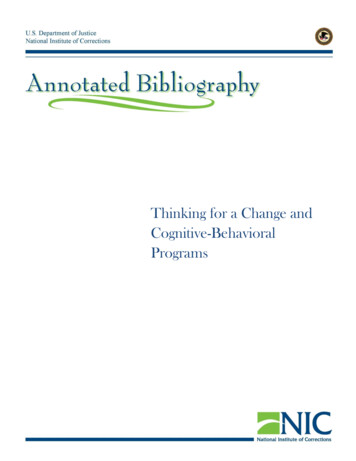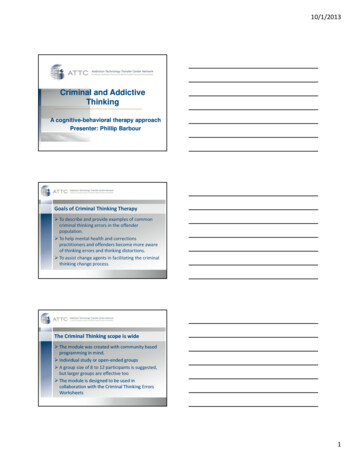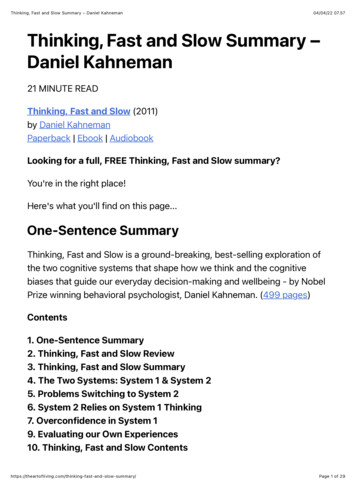
Transcription
Thinking for a Change andCognitive-BehavioralProgramsWorkplace Learning Annotated BibliographyPage 1
Thinking for a Change and Cognitive-Behavioral ProgramsAnnotated BibliographyPrepared by the NIC Information CenterNovember 2014Accession No. 025533An electronic copy of this document can be found at: www.nicic.gov/Library/025533ContentsIntroduction . 2Thinking for a Change . 3Cognitive Behavioral Programs (some studies include T4C) . 6Effectiveness with Youth . 14Thinking for a Change and Cognitive-Behavioral Programs Annotated BibliographyPage 1
IntroductionThis brief bibliography contains research supporting Thinking for a Change as well as CBTprograms for offenders generally. Some of these resources are available through the NICInformation Center: (800) 877-1461, the online Help Desk at http://nicic.gov/helpdesk.The Thinking for a Change: An Integrated Approach to Changing Offender Behavior (T4C) curriculum,developed by Barry Glick, Jack Bush, and Juliana Taymans in cooperation with NIC, “uses acombination of approaches to increase offenders’ awareness of themselves and others. It integratescognitive restructuring, social skills, and problem solving. The program begins by teachingoffenders an introspective process for examining their ways of thinking and their feelings, beliefs,and attitudes. The process is reinforced throughout the program. Social-skills training is providedas an alternative to antisocial behaviors. The program culminates by integrating the skills offendershave learned into steps for problem solving. Problem solving becomes the central approachoffenders learn that enables them to work through difficult situations without engaging in criminalbehavior” (Milkman & Wanberg, 2007).Thinking for a Change and Cognitive-Behavioral Programs Annotated BibliographyPage 2
Thinking for a ChangeBickle, Gayle. “An Intermediate Outcome Evaluation of the Thinking for a Change Program.” OhioDepartment of Rehabilitation and Correction, Bureau of Research and Evaluation, 2013.The research literature on effective offender programming shows that cognitive –behavioral programming creates larger reductions in recidivism than other types ofoffender programming. In light of this evidence, the ODRC adopted the Thinking for aChange (TFAC) program. In 2009, the department encouraged every prison to implementthe TFAC program. The program teaches problem-solving skills, particularly wheninteracting with others, in order to increase rational thinking and lead to pro-socialinteractions and behaviors. In addition, through cognitive restructuring (aka, cognitive selfchange), thought processes are modified to reduce thinking patterns that are conducive tocriminal behavior, i e., antisocial attitudes. This evaluation uses a quasi-experimental, nonrandom, two group pretest post-test design, and it explores intermediate outcomes thatexamine whether the program has influenced participant’s self-assessment of their socialproblem-solving skills and approaches and their acceptance of criminal attitudes. [authorexecutive summary]http://www.drc.ohio.gov/web/Reports/Eval ThinkingforaChange.pdfCenter for Evidence-Based Practice. Effectiveness of Community Corrections in the State of Indiana.CEBP/University of Indiana: Bloomington, 2011.“The purpose of this study was to determine who is served by Indiana CommunityCorrections, and to evaluate the effectiveness of the community corrections program, andits components and services” (p. 37). Results are organized according to who is served inIndiana community corrections, what the effectiveness of community corrections is, whatthe effectiveness of the required components of community corrections is, what theeffectiveness of services is, what combinations of components do offenders participate in,and what the outcomes of those combinations are. The National Institute of Correctionsoffender training program “Thinking for a Change” is the most common service providedwhile also having the highest completion rate of 60%.http://www.nicic.gov/Library/025400Golden, Lori Suzanne, Robert J. Gatcheland, and Melissa Ann Cahill. “Evaluating the Effectiveness ofthe National Institute of Corrections' ‘Thinking for a Change’ Program among Probationers.’”Journal of Offender Rehabilitation 43, no.2 (2006): 55-73.This study evaluated the effectiveness of a National Institute of Corrections' cognitivebehavioral program for adult offenders, entitled "Thinking for a Change." One hundred maleand 42 female probationers were studied. Probationers assigned to the "Thinking for aChange" program were matched with a comparison group not assigned to the program andcontrasted on interpersonal problem-solving skills pre- and post-program completion, andon recidivism at three months to one year post-program. Results indicate a trend towardsThinking for a Change and Cognitive-Behavioral Programs Annotated BibliographyPage 3
lower recidivism, with 33% fewer subjects who completed the program committing newoffenses, compared to those who did not attend the program, over a period of up to 12months. Technical violations of probation were significantly higher for program dropoutsthan for completers or comparisons. Program completers improved significantly oninterpersonal problem-solving skills after "Thinking for a Change," while the dropout andcomparison groups had no such gains.Golden, Lori. Evaluation of the Efficacy of a Cognitive Behavioral Program for Offenders on Probation:Thinking for a Change. 2002.The effectiveness of "Thinking for a Change" -- a cognitive behavioral program for adultprobationers -- is investigated. Following an abstract, this dissertation contains thesechapters: introduction; literature review; study purpose and major aims; method; results;and discussion. While "results for changes and improvements in criminal sentiments foundin the present study [are] disappointing and counter to expectation," there are significantpositive changes in social skills and social problem-solving (p. 90). More importantly, newcriminal offense rates for group completers dropped 33%.http://www.nicic.gov/library/018190Guevara, Michael, Juliana Taymans, and Reggie Prince. "Thinking Controls Behavior." Cuff key toDoor Key: A Systems Approach to Reentry Recorded Session. Washington: NIC, 2013.“This workshop covers the underlying foundations of cognitive behavioral training,including cognitive restructuring and cognitive skills. The panel discusses how cognitivebehavioral principles can help people more effectively negotiate risky situations, solveproblems, and make decisions that can lead them out of trouble. Particular attention is paidto implementing cognitive behavioral programs with integrity in order to get the bestresults. NIC’s "Thinking for a Change" curriculum is highlighted as an example of cognitivebehavioral training mp, Christopher T., Dana Hubbard , Matthew D. Makarios, and Edward J. Latessa. “A QuasiExperimental Evaluation of Thinking for a Change: A ‘Real-World’ Application.” Criminal Justice andBehavior 36, no. 2 (2009): 137-146.Due to the popularity of cognitive behavioral interventions, programs that follow this modelare often assumed to be effective. Yet evaluations of specific programs have been slow incoming. The current investigation seeks to bridge this gap by evaluating the effectiveness ofThinking for a Change, a widely used cognitive behavioral curriculum for offenders.Furthermore, this evaluation provides a “real-world” test of T4C, because it wasimplemented by line staff in a community corrections agency as opposed to being a pilotproject implemented by program developers.The results of the analyses indicate that offenders participating in the TFACprogram had a significantly lower recidivism rate than similar offenders that were notexposed to the program. In this study, the authors compared the recidivism rates of 121offenders on probation that received T4C to 97 offenders on probation supervision that didnot receive T4C. Offenders participating in T4C and those not participating in T4C wereThinking for a Change and Cognitive-Behavioral Programs Annotated BibliographyPage 4
drawn from a similar time period and from the same jurisdiction. The follow-up time periodranged from 6 to 64 months with the average follow up being 26 months. Other measuresincluded a risk score (summed score of prior arrests, prior prison, prior communitysupervision violations, history of drug use, history of alcohol problems, highest gradecompleted, employment status at arrest), age, sex, and race. The outcome measure was newarrest for any new criminal behavior during the follow up period.Two statistical models were used. The first compared all the T4C participants to thenon-participants. The second model compared only those offenders that successfullycompleted T4C to those offenders that did not participate in T4C. The findings of thesemodels revealed significant and substantive differences in the likelihood of arrest betweenthe groups of offenders. The 121 offenders that received some exposure to the T4C programbut didn’t necessarily successfully complete T4C had an adjusted recidivism rate of 23%.Those offenders that successfully completed T4C (n 90) had an adjusted recidivism rate of18%. Finally, those offenders that did not participate in T4C programming (n 97) had anadjusted recidivism rate of 35%. These differences are net the effects of other controlvariables such as race, age, sex, and risk level. [JOURNAL ABSTRACT]Makarios, Matthew D. “Program Profile: Thinking for a Change.” Crimesolutions. 2014.This website uses rigorous research to inform practitioners and policy makers about whatworks in criminal justice, juvenile justice, and crime victim services. A profile of theThinking for a Change program includes an overall evidence rating, and the program goals,target population, theory and tails.aspx?ID 242Thinking for a Change and Cognitive-Behavioral Programs Annotated BibliographyPage 5
Cognitive Behavioral Programs (some studies include T4C)Antonowicz, D.H. and J. Parker. “Reducing Recidivism: Evidence from 26 Years of InternationalEvaluations of Reasoning & Rehabilitation Programs.” Wilfrid Laurier University, 2012.“One of the earliest cognitive-behavioral programs is the Reasoning and Rehabilitation(R&R) R&R teaches offenders cognitive, emotional and social skills and values that arerequired for pro-social competence and are antagonistic to antisocial behavior. It trainsoffenders in skills and values that enable them to withstand environmental and personalfactors that engender antisocial behavior R&R programs are also among the mostfrequently evaluated programs in the criminal justice field. Their efficacy in reducingrecidivism has been demonstrated in a remarkable number of evaluations. The presentreport presents the major findings of each of the independent controlled evaluations of R&Rand R&R2 that have been conducted in many countries over more than 26 years since theprogram was first developed and evaluated in Canada. The report documents the success ofmany applications of the R&R/R&R2 model but also indicates several factors that havelimited or prevented its Reasoning and Rehabilitation Review.pdfAos, Steve, Marna Miller, and Elizabeth Drake. Evidence-based Adult Corrections Programs: WhatWorks and What Does Not. Olympia: Washington State Institute for Public Policy, 2006.A systematic review of evidence-based programs for adult offenders, looking at 291evaluations previously conducted in the U.S. and other English-speaking countries.Regarding Cognitive-behavioral Treatment, the researchers found “25 rigorous evaluationsof program for the general offender population that employ CBT . On average, we foundthese programs significantly reduce recidivism by 8.2 percent. We identified three welldefined programs that provide manuals and staff training regimens: Reasoning andRehabilitation (R&R), Moral Reconation Therapy (MRT), and Thinking for a Change (T4C).”The results of this study also indicate reductions in recidivism of low-risk sex offenders onprobation, as well sex offenders in .pdfAshford, Jose B., Kai W. Wong, and Katherine O. Sternback. "Generic Correctional Programming forMentally Ill Offenders: A Pilot Study." Criminal Justice and Behavior 35, no. 4 (2008): 457-473.This pilot study examined differences in criminal attitudes and hostile attribution biasesamong three groups of offenders diagnosed with serious mental disorders. It also comparedthe criminal outcomes for a sample of mentally ill offenders (MIO's) who completed amodified version of the Options cognitive skills program with a treatment-as-usual sampleof MIO's. Results showed that pre- and posttest change scores for the Overgeneralizationsubscale of the Hostile Interpretations Questionnaire (HIQ), the Identification with CriminalOthers subscale of the Criminal Sentiments Scale-Modified (CSS-M), and the HIQ Authoritysubscale differed between the groups of offenders with serious mental disorders.Participants identified for treatment by the pilot program (intended treatment group) andThinking for a Change and Cognitive-Behavioral Programs Annotated BibliographyPage 6
participants who completed the entire intervention had fewer arrests, including fewerarrests for violent offenses, but had higher technical probation violations than a treatmentas-usual comparison group.Bickle, Gayle. What Works? General Principles, Characteristics, and Examples of Effective Programs.Ohio Dept. of Rehabilitation and Correction, Office of Policy and Offender Reentry. Bureau ofResearch. Columbus, OH, 2010.This is an excellent introduction to “What Works” in correctional programming. “Thepurpose of this paper is to identify the major characteristics of effective offenderprogramming as found in the research literature and provide a description of programs thatwork. The hope is that this document can assist administrative and treatment staff in thedesign and implementation of effective offender programming” (p. 3). Topics coveredinclude: the death and rebirth of correctional programming; what the seven generalprinciples and characteristics of effective treatment programs are; and evidence-basedprogramming for criminogenic needs—recovery services programming, educationalprogramming, employment programming, attitudes/associates/social interaction(cognitive-behavioral programs), marital/family relations programming, and programsaddressing mental health problems. This report ends with a great chart showing the variousprogram types, program description, recidivism reduction outcomes, and any othersignificant research ive%20programs.pdfCarr, T.R., Jeanie Thies, and Rhonda A. Penelton. “An Evaluation of the Moral Reconation Therapy ofthe Franklin/Jefferson County Evening Reporting Center Program.” Southern Illinois University atEdwardsville, Department of Public Administration and Policy Analysis (Edwardsville, IL), 2005.Results from an 18-month evaluation of the Moral Reconation Therapy (MRT) provided bythe Evening Reporting Centers (ERC) of the Illinois Fourth Probation District of the SecondJudicial Circuit are presented. Seven sections follow an executive summary: evaluationdesign overview; a review of the literature; Franklin and Jefferson counties overview;history and description of Franklin/Jefferson county ERC and MRT; process evaluation;outcome evaluation; and summary of findings and recommendations. While only 13.5% ofERC participants in Franklin County committed new offenses upon release, reductions indelinquency of 41% were experienced by Jefferson County participants only while theywere enrolled in chReports/moralreconation.pdfClark, Patrick M. “Cognitive Behavioral Therapy: An Evidence-based Intervention for Offenders.”Corrections Today 73, no. 1 (2011): 62-64.This short article is a revision of “Preventing Future Crime with Cognitive BehavioralTherapy,” originally published in the National Institute of Justice Journal (Issue No. 265) andexplains the CBT has been found to be effective with juvenile and adult offenders (low- andhigh-risk), sex offenders, and in a variety of correctional settings in the community and ininstitutions.Thinking for a Change and Cognitive-Behavioral Programs Annotated BibliographyPage 7
Gehring, Krista S., Patricia Van Voorhis, and Valerie R. Bell. “What Works for Female Probationers?An Evaluation of the Moving On Program.” Women, Girls, and Criminal Justice 11, no. 1 (2010): 1,610.The effectiveness of the Moving On program is evaluated. Moving On is a gender-responsive,cognitive behavioral program for women probationers. Sections of this report include:program description; data and study design; sample; outcome measures; results forrearrests, convictions, incarcerations, and technical violations; effects of programcompletion on rearrests, convictions, incarcerations, and technical violations; andimplications of the findings. “The findings from this study indicate the Moving On programwould be a good fit for agencies looking for an evidence based gender-responsive program”(p. s/docs/MOVING%20ON.pdfHyatt, Jordan. The Impact of Cognitive-Behavioral Therapy on the Recidivism of High RiskProbationers: Results from a Randomized Trial. Publicly Accessible Penn Dissertations. Paper 644,2013.Community corrections are being used with increasing regularity for the supervision andmanagement of serious and violent offenders. Attempts to increase the frequency andseverity of conditions of supervision have not resulted in meaningful decreases in crimerates among this population. Some encouraging results, however, have been observed whena treatment component is integrated into supervision protocols. This dissertation firstexamines the theories and current research that inform this shift in strategies. Secondly, weevaluate for the first time, a cognitive-behavioral therapy intervention developed to reducerecidivism within a high-risk, male probation tent.cgi?article 1802&context edissertationsLandenberger, Nana A., and Mark W. Lipsey. “The Positive Effects of Cognitive-Behavioral Programsfor Offenders: A Meta-Analysis of Factors Associated with Effective Treatment.” Journal ofExperimental Criminology 1 (2005): 451-476.A meta-analysis of 58 experimental and quasi-experimental studies of the effects ofcognitive-behavioral therapy (CBT) on the recidivism of adult and juvenile offendersconfirmed prior positive findings and explored a range of potential moderators to identifyfactors associated with variation in treatment effects. With method variables controlled, thefactors independently associated with larger recidivism reductions were treatment ofhigher risk offenders, high quality treatment implementation, and a CBT program thatincluded anger control and interpersonal problem solving but not victim impact or behaviormodification components. With these factors accounted for, there was no difference in theeffectiveness of different brand name CBT programs or generic forms of CBT. com/f/Landenberger Lipsey.pdfThinking for a Change and Cognitive-Behavioral Programs Annotated BibliographyPage 8
Latessa, Edward. Designing More Effective Correctional Programs Using Evidence-Based Practices.Tokyo: United Nations Asia and Far East Institute for the Prevention of Crime and the Treatment ofOffenders (UNAFEI), 2012.Are you looking for a research-based primer on evidence-based practices. Then this articleis the place to start. “Through the lens of RNR [risk, need, and responsivity] scholars andpractitioners alike have a framework by which they can better study and understandcriminal conduct and the effectiveness (or lack thereof) of correctional programs. Thismodel has been widely accepted in the USA, and I believe that approach provides aframework for designing effective correctional programs. This paper will examine theprinciples that underlie effective programs and discuss how these principles translate intoactual practice” (p. 48). Sections of this document include: introduction; evidence-baseddecision-making; what the research tells us about effective correctional programs—principles of effective intervention, risk principle, need principle, and responsivity (or the“how”); behavioral approaches in corrections—social-learning and cognitive-behavioralinterventions, core correctional practices, and effective practices in correctionalsupervision; results from a range of correctional programs; and summary.http://www.unafei.or.jp/english/pdf/RS No88/No88 10VE Latessa Designing.pdfLatessa, Edward, Paula Smith, and Myrinda Schweitzer. Evaluation of Selected Institutional OffenderTreatment Programs for the Pennsylvania Department of Corrections: Final Report. University ofCincinnati, 2009.The University of Cincinnati’s Center for Criminal Justice Research conducted evaluation offive treatment programs in 24 institutions within the Pennsylvania Department ofCorrections to identify strengths and areas for improvement. The programs—Thinking for aChange (T4C), Batterer’s Intervention, Violence Prevention, and two Sex Offenderprograms—were evaluated using the Correctional Program Checklist (CPC) and CPC-GroupAssessment (CPC-GA) and examined the extent to which the programs adhered to theprinciples of effective intervention. Numerous components must be in place in order forevidence-based group interventions to maintain program integrity. Indicators of ProgramIntegrity on the CPC-GA include: an individual dedicated to oversee and manage the group,and select and supervise group facilitators; facilitators must meet specific qualifications;formal training should be conducted regularly, along with formal meetings about theprogram; ethical guidelines need to be honored; and support must exist from keystakeholders. CPC Indicators include having an engaged program coordinator with thenecessary skills and experience to work with staff and offenders, and ground work must bedone in advance, such as literature reviews and piloting of the program. Stable andadequate funding for the program helps to ensure effectiveness, along with involvementand input from the staff and ongoing clinical supervision and service delivery skillstraining/coaching.“The Thinking for a Change results in the area of treatment program integrityindicators were consistent with the overall results of the agency with two exceptions. Thefirst is that Thinking for a Change is considered an evidence-based curriculum as itintegrates key cognitive-behavioral techniques and the principles of social learning theoriesThinking for a Change and Cognitive-Behavioral Programs Annotated BibliographyPage 9
consistently throughout the manual. The second and related difference is that the curriculum regularly integrates modeling and role-playing with corrective feedback intogroup sessions” (p. 38).http://nicic.gov/Library/024463Lindhout, Alisha. Offender Participation in Cognitive Based Treatment Programs and the Effects onRecidivism. Sarasota: University of South Florida, 2013.Recidivism can be defined as “the return of a criminal to crime within a specified timeinterval after release from prison or completion of a punishment for a prior conviction”(Tebbitt, 2011, p.1). Although there has been a decline in the recidivism rate over the years,it remains to be an issue in the United States, and in Florida. Because of this issue, manypeople are trying to figure out a way to keep offenders from committing new crimes andreturning to prison. One idea is the use of Cognitive Based Treatment Programs. Therefore,this paper asks the question “Does offender participation in a CBT reentry program affectthe offender’s probability of reoffending?” To answer this question, the paper will look intopreviously conducted studies to see what information researchers have already found onthis topic and will explain a new approach to answer this question. This paper contains aliterature review of the previously conducted studies which have examined similarquestions. Next this paper will discuss the methodology that was used to help answer thisquestion including the explanation of the dependent and independent variables used in thestudy. Finally, this paper will examine the expected findings and the implications thatoccurred when researching this question. [Author /capstone/20122013/criminology/lindhout on%20recidivism.pdfLipsey, Mark. W., Gabrielle L, Chapman, and Nana A. Landenberger. “Cognitive behavioral programsfor Offenders.” The Annals of the American Academy of Political and Social Science 578: (2001): 144157.A systematic review using meta-analysis techniques was conducted with 14 studies selectedto provide the best evidence on the effectiveness of cognitive-behavioral programs forreducing re-offense recidivism of criminal offenders. The results indicated that, overall,cognitive-behavioral programs are effective, and the best of them are capable of producingsizable reductions in recidivism. Many of the available studies, however, investigateresearch-oriented demonstration programs; the effectives found for routine practicalprogram were notably smaller. Moreover, the research coverage of both juvenile and adultprograms in institutional and non-institutional settings is uneven and leaves troublesomegaps in evidence. [JOURNAL ABSTRACT]Lipsey, Mark, et al., Effects of Cognitive-Behavioral Programs for Criminal Offenders: A SystematicReview. Campbell Systematic Reviews, 2007Much research on the subject shows that cognitive-behavioural therapy effectively reduces therecidivism of offenders after serving their sentences. There is, however, a significantThinking for a Change and Cognitive-Behavioral Programs Annotated BibliographyPage 10
difference in how effective the different treatment programmes that use this form oftherapy are, but further research is required to identify what sets them apart from eachother. 9/McGrath, Michael P. “Making ‘What Works’ Work for Rural Districts.” Federal Probation 72, no. 2(September, 2008).This article describes the implementation and evaluation of cognitive behavioral therapy(CBT) in Federal probation case management conducted in the predominantly rural FederalDistrict of North Dakota under a grant from the Federal Research to Results (R2R) urts/PPS/Fedprob/200809/08 rural districts.htmlMilkman, Harvey and Kenneth Wanberg. Cognitive-Behavioral Treatment: A Review and Discussionfor Corrections Professionals. Washington: National Institute of Corrections, 2007.Detailed information regarding the use and benefits of cognitive-behavioral therapy (CBT)in prisons and jails is provided. Chapters comprising this address: the increasing need foreffective treatment services; what cognitive-behavioral therapy is; prominent CBTprograms for offenders; measuring the effectiveness of rehabilitation programs; evaluatingspecific CBT curricula; and “real-world” program y/021657.pdfPalmer, Emma J., Ruth M. Hatcher, James McGuire, Clive R. Hollin, “Cognitive Skills Programs forFemale Offenders in the Community: Effect on Reconviction.” Criminal Justice and Behavior (OnlineOctober, 2014)This article reports an evaluation of two cognitive skills programs (Enhanced ThinkingSkills and Think First) with 801 women offenders serving community sentences in theEnglish and Welsh Probation Service. A quasi-experimental design was used to compare thereconviction rates at 1-year follow-up of offenders who completed the program, offenderswho started but did not complete the program, and a comparison group that were notallocated to the program. Multivariate analysis showed that the completers did not have asignificantly lower rate of reconviction than the comparison group. However, the noncompleters had a significantly higher rate of reconviction than the comparison group. Nodifferences were found in reconviction between the completers group and non-completersgroup. The implications of the findings for interventions with women offenders 2014/10/09/0093854814552099Rotter, Merrill and Amory W. Carr. “Reducing Criminal Recidivism for Justice-Involved Persons withMental Illness: Risk/Needs/Responsivity and Cognitive-Behavioral Interventions.” Delmar, NY:GAINS Center for Behavioral Health and Justice Transformation, 2014.If you work with mentally ill offenders you will find this publication very useful. “In thisdocument, we [the authors] review the leading offender recidivism–targeted interventionparadigm: Risk/Needs/Responsivity (RNR) In particular, we focus on criminal thinking,Thinking for a Change and Cognitive-Behavioral Programs Annotated BibliographyPage 11
one of the ident
Wilfrid Laurier University, 2012. "One of the earliest cognitive-behavioral programs is the Reasoning and Rehabilitation . Ashford, Jose B., Kai W. Wong, and Katherine O. Sternback. . Criminal Justice and Behavior 35, no. 4 (2008): 457-473. This pilot study examined differences in criminal attitudes and hostile attribution biases among .











